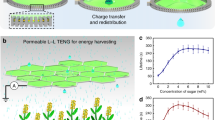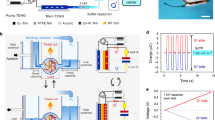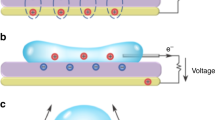Abstract
Extensive efforts have been made to harvest energy from water in the form of raindrops1,2,3,4,5,6, river and ocean waves7,8, tides9 and others10,11,12,13,14,15,16,17. However, achieving a high density of electrical power generation is challenging. Traditional hydraulic power generation mainly uses electromagnetic generators that are heavy, bulky, and become inefficient with low water supply. An alternative, the water-droplet/solid-based triboelectric nanogenerator, has so far generated peak power densities of less than one watt per square metre, owing to the limitations imposed by interfacial effects—as seen in characterizations of the charge generation and transfer that occur at solid–liquid1,2,3,4 or liquid–liquid5,18 interfaces. Here we develop a device to harvest energy from impinging water droplets by using an architecture that comprises a polytetrafluoroethylene film on an indium tin oxide substrate plus an aluminium electrode. We show that spreading of an impinged water droplet on the device bridges the originally disconnected components into a closed-loop electrical system, transforming the conventional interfacial effect into a bulk effect, and so enhancing the instantaneous power density by several orders of magnitude over equivalent devices that are limited by interfacial effects.
This is a preview of subscription content, access via your institution
Access options
Access Nature and 54 other Nature Portfolio journals
Get Nature+, our best-value online-access subscription
$29.99 / 30 days
cancel any time
Subscribe to this journal
Receive 51 print issues and online access
$199.00 per year
only $3.90 per issue
Buy this article
- Purchase on Springer Link
- Instant access to full article PDF
Prices may be subject to local taxes which are calculated during checkout




Similar content being viewed by others
Data availability
The data that support the findings of this study are available from the corresponding authors on reasonable request.
References
Lin, Z.-H., Cheng, G., Lee, S., Pradel, K. C. & Wang, Z. L. Harvesting water drop energy by a sequential contact-electrification and electrostatic-induction process. Adv. Mater. 26, 4690–4696 (2014).
Jeon, S.-B., Kim, D., Yoon, G.-W., Yoon, J.-B. & Choi, Y.-K. Self-cleaning hybrid energy harvester to generate power from raindrop and sunlight. Nano Energy 12, 636–645 (2015).
Xiong, J. et al. Wearable all-fabric-based triboelectric generator for water energy harvesting. Adv. Energy Mater. 7, 1701243 (2017).
Jin, S. et al. Large-area direct laser-shock imprinting of a 3D biomimic hierarchical metal surface for triboelectric nanogenerators. Adv. Mater. 30, 1705840 (2018).
Xu, W. H. et al. SLIPS-TENG: robust triboelectric nanogenerator with optical and charge transparency using a slippery interface. Natl Sci. Rev. 6, 540–550 (2019).
Yu, J., Ma, E. & Ma, T. Exponential energy harvesting through repetitive reconfigurations of a system of capacitors. Commun. Phys. 1, 9 (2018).
Wang, Z. L. New wave power. Nature 542, 159–160 (2017).
Zhu, G. et al. Harvesting water wave energy by asymmetric screening of electrostatic charges on a nanostructured hydrophobic thin-film Surface. ACS Nano 8, 6031–6037 (2014).
Scruggs, J. & Jacob, P. Harvesting ocean wave energy. Science 323, 1176–1178 (2009).
Dhiman, P. et al. Harvesting energy from water flow over graphene. Nano Lett. 11, 3123–3127 (2011).
Logan, B. E. & Elimelech, M. Membrane-based processes for sustainable power generation using water. Nature 488, 313–319 (2012).
Siria, A. et al. Giant osmotic energy conversion measured in a single transmembrane boron nitride nanotube. Nature 494, 455–458 (2013).
Feng, J. et al. Single-layer MoS2 nanopores as nanopower generators. Nature 536, 197–200 (2016).
Schroeder, T. B. H. et al. An electric-eel-inspired soft power source from stacked hydrogels. Nature 552, 214–218 (2017).
Xue, G. et al. Water-evaporation-induced electricity with nanostructured carbon materials. Nat. Nanotechnol. 12, 317–321 (2017).
Huang, Y. et al. Interface-mediated hygroelectric generator with an output voltage approaching 1.5 volts. Nat. Commun. 9, 4166 (2018).
Chen, X. et al. Scaling up nanoscale water-driven energy conversion into evaporation-driven engines and generators. Nat. Commun. 6, 7346 (2015).
Nie, J. et al. Power generation from the interaction of a liquid droplet and a liquid membrane. Nat. Commun. 10, 2264 (2019).
Sun, Q. et al. Surface charge printing for programmed droplet transport. Nat. Mater. 18, 936–941 (2019).
Cui, L. et al. The comparative studies of charge storage stabilities among three PP/porous PTFE/PP electret. J. Electrost. 67, 412–416 (2009).
Xia, Z., Gerhard-Multhaupt, R., Künstler, W., Wedel, A. & Danz, R. High surface-charge stability of porous polytetrafluoroethylene electret films at room and elevated temperatures. J. Phys. D 32, L83 (1999).
Yatsuzuka, K., Mizuno, Y. & Asano, K. Electrification phenomena of pure water droplets dripping and sliding on a polymer surface. J. Electrost. 32, 157–171 (1994).
Zhao, P. et al. Emulsion electrospinning of polytetrafluoroethylene (PTFE) nanofibrous membranes for high-performance triboelectric nanogenerators. ACS Appl. Mater. Interfaces 10, 5880–5891 (2018).
Wang, S. et al. Maximum surface charge density for triboelectric nanogenerators achieved by ionized-air injection: methodology and theoretical understanding. Adv. Mater. 26, 6720–6728 (2014).
Thomson, W. On a self-acting apparatus for multiplying and maintaining electric charges, with applications to illustrate the voltaic theory. Proc. R. Soc. Lond. 16, 67–72 (1868).
Liu, Y. et al. Pancake bouncing on superhydrophobic surfaces. Nat. Phys. 10, 515–519 (2014).
Bird, J. C., Dhiman, R., Kwon, H.-M. & Varanasi, K. K. Reducing the contact time of a bouncing drop. Nature 503, 385–388 (2013); erratum 505, 436 (2014).
Richard, D., Clanet, C. & Quéré, D. Contact time of a bouncing drop. Nature 417, 811 (2002).
Nguyen, V. & Yang, R. Effect of humidity and pressure on the triboelectric nanogenerator. Nano Energy 2, 604–608 (2013).
Sessler, G. M. in Electrets (ed. Sessler, G. M.) 13–80 (Springer, 1980).
Moon, J. K., Jeong, J., Lee, D. & Pak, H. K. Electrical power generation by mechanically modulating electrical double layers. Nat. Commun. 4, 1487 (2013).
Abascal, J., Sanz, E., García Fernández, R. & Vega, C. A potential model for the study of ices and amorphous water: TIP4P/Ice. J. Chem. Phys. 122, 234511 (2005).
Koneshan, S. R., Rasaiah, J. C., Lynden-Bell, R. M. & Lee, S. H. Solvent structure, dynamics, and ion mobility in aqueous solutions at 25 °C. J. Phys. Chem. B 102, 4193–4204 (1998).
Acknowledgements
Z.W. acknowledges financial support from the National Natural Science Foundation of China (grant 31771083), the Research Grants Council of Hong Kong (grants 11219219, C1018-17G and 11218417), the Shenzhen Science and Technology Innovation Council (grant JCYJ20170413141208098), the Innovation and Technology Council (grants 9440175), and the City University of Hong Kong (grants 9680212 and 9600011). X.C.Z. was supported by the United States National Science Foundation (CHE-1665324). X.Z. was supported by the Science and Technology Committee of the Shanghai Municipality (grant 19511120100) and by Initial Funding for Scientific Research of East China Normal University. Molecular-dynamics simulations were carried out using the computer facility at the University of Nebraska-Lincoln Holland Computing Center.
Author information
Authors and Affiliations
Contributions
Z.W. and W.X. conceived the research. W.X., H.Z., X.Z. and C.Z. designed the experiments. W.X. prepared the samples. W.X., H.Z. and Y.S. carried out the experiments. Y.L. and X.C.Z. conducted the molecular-dynamics simulations. All authors analysed the data. Z.W., R.X.X., X.D., X.C.Z., W.X., Z.L.W., X.Z., Y.L., M.L., Z.Y. and H.Z. wrote the manuscript.
Corresponding authors
Ethics declarations
Competing interests
The authors declare no competing interests.
Additional information
Peer review information Nature thanks Lars Egil Helseth and the other, anonymous, reviewer(s) for their contribution to the peer review of this work.
Publisher’s note Springer Nature remains neutral with regard to jurisdictional claims in published maps and institutional affiliations.
Extended data figures and tables
Extended Data Fig. 1 Surface morphology and sliding behaviour of water droplets on the PTFE film and aluminium electrode.
a, SEM image of the PTFE film used in our DEG. Upon curing at 120 °C and solvent evaporation, the PTFE precursor is transformed into a smooth and dense PTFE film. b, Photograph of the fabricated PTFE film together with the ITO glass on a logo, showing the high transparency of the film. c, A droplet of roughly 30.0 μl can easily slide on the surface of a PTFE film made from pure PTFE solution (placed on a substrate with a tilt angle of 15.0°). d, Contour graph image of an aluminium electrode shows that its surface is very flat and uniform. e, A droplet can slide off an aluminium electrode without leaving residual water. The aluminium electrode is placed on a substrate with a tilt angle of 25.0°. These is no residual water on the electrode surface.
Extended Data Fig. 2 Surface charging by continuous droplet impinging, and characterization of the output charge and power of the DEG.
a, Variation in the output voltage as a function of the number of individual impinging droplets. In this case, the surface was not precharged. The output results purely from charge generation and transfer during droplet impinging. b, The output charge measured from the DEG (in red; the frequency of impinging droplets is 4.2 Hz and the total number of droplets is about 42) is roughly 49.8 nC, which is around 640.1 times higher than that of the control device (in black; the frequency of impinging droplets is 1.0 Hz, and the total number of droplets is 9). c, When the load resistance increases from 1 kΩ to 100 MΩ, the output current decreases from 250.0 μA to 2.0 μA. When the load resistance is 332.0 kΩ, the peak output power density is 50.1 W m−2.
Extended Data Fig. 3 Control experiment based on a triboelectric nanogenerator.
a, Optical image showing the as-fabricated control device. The structure of this control device is similar to that of the DEG, but without an aluminium electrode. b, Diagram showing its detailed working mechanism. i, Before the droplet contacts the PTFE, the amount of (positive) charges on the ITO is the same as the (negative) charges on the PTFE, owing to electrostatic induction. Thus, there is no current flow from ITO to the ground. ii, When a water droplet contacts the PTFE surface, the droplet becomes positively charged while the PTFE becomes more negatively charged as a result of contact electrification. iii, When the positively charged droplet leaves, it causes the ITO electrode with positive charges to be unable to screen the more negatively charged PTFE. iv, Accordingly, a flow of current (I) between the ground and ITO electrode is induced by electrostatic induction. c, Variation in voltage output from the control device as a result of continuous droplet impinging. The inset shows the time-dependent variation in voltage from a single droplet. The frequency of impinging droplets is set at 1.0 Hz, with a total of nine droplets. d, In each test of the control device, the amount of transferred charge (in green) is identical to the charge carried by the departing droplets (in blue), showing that electricity generation from the control device indeed originates from contact electrification. The frequency of impinging droplets is 1.0 Hz, with a total of nine droplets.
Extended Data Fig. 4 Enhanced electrical output using the ion-injection method.
a, Comparison of the output voltage generated from a single droplet impinging on a DEG that was precharged by droplet impinging (in red) or by ion injection (in blue). b, Comparison of the amount of electrical energy (Eout) generated from a single droplet impinging on a DEG charged by droplet impinging (in red) or ion injection (in blue). The instantaneous peak density can be enhanced further by increasing the surface charge on the PTFE film through ion injection, using a commercial antistatic gun (Zerostat3, Milty) to inject various ions, including CO3−, NO3−, NO2−, O3− and O2−, from a vertical distance of roughly 5.0 cm. c, Variation in the measured maximum charge, Qmax, with droplet impinging on a PTFE surface that was precharged using ion injection. Qmax decays rapidly and finally reaches a stable value of roughly 49.8 nC. The inset shows the Qmax for the first four droplets.
Extended Data Fig. 5 Effect of surface charge on the maximum spreading area, Amax, of a droplet.
Data are means ± s.e.m. For each mean, the total number of measurements is ten.
Extended Data Fig. 6 Effect of the spatial location and width of the aluminium electrode on electricity generation.
a, The spatial location of the aluminium electrode was changed, keeping the impact location fixed. In this way, the spacing between the droplet centre and the electrode can be tailored. Insets marked with 1, 2, 3, 4 refer to the four different locations of the aluminium electrode on the PTFE surface. The results show that regardless of the electrode location, the output voltage is constant, suggesting that electricity generation is not sensitive to electrode location. Data are means ± s.e.m. For each mean, the total number of measurements is ten. b, The output voltage does not depend on the size of the aluminium electrode. This makes sense because the source of electricity generation is the electrostatically induced charge on the ITO, rather than on the aluminium. Data are means ± s.e.m. For each mean, the total number of measurements is ten.
Extended Data Fig. 7 Molecular-dynamics simulation.
a, In the molecular-dynamics simulation, negative (blue) and positive (yellow) charges are fixed on atomic layers of PTFE (grey) and ITO (red), respectively. b, Molecular-dynamics simulation showing the distribution of mobile charges (Na+ and Cl−) inside the water and on the PTFE surface in switched-off mode (that is, without an aluminium electrode, although the negative and positive charges on PTFE and ITO are turned on). c, Molecular-dynamics simulation showing the distribution of charges inside the water and on the PTFE surface in switched-on mode. d, Comparison of the number of mobile charges transferred to the water/solid interface in switched-on and switched-off modes.
Extended Data Fig. 8 Control devices made of porous PTFE, PDMS and PP.
Comparison of the maximum stable surface charge, Qmax, on control devices made of porous PTFE, PDMS and polypropylene (PP) after continuous droplet impact under a relative humidity of 65.0%; all of these charges are much smaller than that of our DEG surface.
Extended Data Fig. 9 Thickness of PTFE film as a function of the volume of PTFE precursor.
The thickness of the PTFE film increases linearly from 6.7 μm to 16.9 μm as the volume of PTFE precursor increases from 100.0 μl to 250.0 μl.
Supplementary information
Video 1: 400 commercial LEDs instantaneously powered by continuous droplets impinging on four individual DEG devices.
400 commercial LEDs can be instantaneously powered to light up when four droplets of 100.0 μl released from a height of 15.0 cm contact the device, demonstrating the dramatic boost in the peak power density generated from the DEG.
Video 2: Synchronization of the droplet spreading dynamics and time-dependent variation of charges Q.
Droplet is released from a pre-determined location to the surface of the as-fabricated DEG. When the spreading droplet contacts the Al electrode, there is a rapid increase in the measured charges, which flow from the ITO to the Al electrode. With the progression of droplet spreading, the charge transfer between PTFE/ITO and Al electrode continues until reaching the maximum spreading area Amax, which is associated with the maximum Qmax =49.8 nC. Then, with the retraction and sliding of the droplet, the charges flow back from the Al electrode to ITO. When the droplet fully detaches from the Al electrode at toff = 16.0 ms, the measured charge drops to zero.
Video 3: Home-made platform for the on-demand water collection and automatic droplet dispensing.
The raindrops were collected on July 31, 2019 in Hong Kong, China. Droplet size and velocity can be tailored by adjusting the diameter of capillary tubing as well as the releasing height. Such a platform can also compartment continuous sea water flow into discontinuous droplet arrays, allowing for efficient and on-demand electricity generation of a wide range of water sources.
Rights and permissions
About this article
Cite this article
Xu, W., Zheng, H., Liu, Y. et al. A droplet-based electricity generator with high instantaneous power density. Nature 578, 392–396 (2020). https://doi.org/10.1038/s41586-020-1985-6
Received:
Accepted:
Published:
Issue Date:
DOI: https://doi.org/10.1038/s41586-020-1985-6
This article is cited by
-
Rewritable printing of ionic liquid nanofilm utilizing focused ion beam induced film wetting
Nature Communications (2024)
-
Nature-inspired interfacial engineering for energy harvesting
Nature Reviews Electrical Engineering (2024)
-
Robust, breathable, and chemical-resistant polytetrafluoroethylene (PTFE) films achieved by novel in-situ fibrillation strategy for high-performance triboelectric nanogenerators
Nano Research (2024)
-
Water-solid contact electrification and catalysis adjusted by surface functional groups
Nano Research (2024)
-
A Review of Contact Electrification at Diversified Interfaces and Related Applications on Triboelectric Nanogenerator
Nano-Micro Letters (2024)
Comments
By submitting a comment you agree to abide by our Terms and Community Guidelines. If you find something abusive or that does not comply with our terms or guidelines please flag it as inappropriate.



